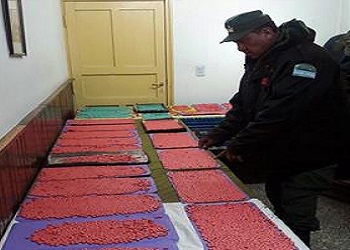Microtrafficking is on the rise in Argentina, according to a new report. New trends are impacting the trafficking landscape, but also raise questions over the right policies to tackle the issue.
The study by the Pontifical Catholic University of Argentina (Universidad Cátolica Argentina – UCA) shows that microtrafficking has constantly increased from 2010 to 2016. Nearly half of surveyed Argentinians said they witnessed drug trafficking activities in their neighborhood during 2016, compared to barely 30 percent of respondents in 2010.
The highest rates of microtrafficking were reported in the urban centers of the Pampas region, and those of the Northwestern region (Noroeste Argentino – NOA), according to the study. The biggest increases, however, were registered in Patagonia and the Northeastern parts of Argentina (Noreste Argentino – NEA). The Buenos Aires Metropolitan Area, the NEA and the NOA’s urban areas have the highest prevalence of reported drug addiction problems.
Poor and disadvantaged neighborhoods show both higher levels and greater increases of microtrafficking over the years, according to the most recent findings. More than 65 percent of residents in areas with low socio-economic indicators and nearly 80 percent of those living in “villas” (Argentina’s urban slums) reported having witnessed drug trafficking in their neighborhoods. Areas with a lower police presence also registered higher levels of microtrafficking.
SEE ALSO: Coverage of Microtrafficking
Meanwhile, Argentina’s La Nación recently pointed to the possible development of a new ecstasy trafficking route through the country’s Northwestern provinces bordering Bolivia and Paraguay — areas that have previously been signaled as important transit points by an earlier UCA report.
More than 90,000 doses of ecstasy have been seized in the Jujuy and Formosa provinces in 2017, a significant increase in comparison to the whole of 2016, during which annual seizures reached just under 71,000 doses. Citing an anonymous antinarcotics official, La Nación said that synthetic drug traffickers were now using routes originating from neighboring Bolivia and Paraguay traditionally used to smuggle cocaine paste and marijuana. Large seizures of ecstasy, produced mostly in Europe, have generally been seen in airports and maritime ports nearer to Buenos Aires.
InSight Crime Analysis
Concerns have risen in Argentina in recent years over increases in the domestic trafficking market and local consumption, so much so that Pope Francis was prompted to speak out on the issue towards the end of last year. The trend of rising consumption is a likely consequence of the country’s role as a drug transshipment point.
Although synthetic drugs such as ecstasy are not the most consumed in Argentina — the UCA report ranks marijuana and cocaine as the most popular drugs – the growing volume of seizures of these substances speaks to the trend of increasing overall consumption. The amount of synthetic drugs seized between the first ten months of 2015 and 2016 reportedly multiplied by five.
It’s possible that the increase in demand led to the development of new routes for ecstasy, as argued by La Nación. Argentina’s growing synthetic drug use has been a trigger for domestic production — although European synthetic substances maintain a large share of Argentina’s market, the country’s first synthetic drug lab was discovered in 2013.
Authorities have been struggling to tackle this growing problem. Due to the country’s inefficient legislative framework, the size of Argentina’s federal prison population incarcerated for drug-related crimes more than doubled in ten years, with drug consumers making up for half of those behind bars, more than those charged with drug trafficking.
In addition, and as shown by the UCA report’s data, there is a clear correlation between socio-economic factors and the development of the local drug trade, so focusing just on punitive measures against individuals involved in the drug trade promises to prove insufficient.
SEE ALSO: Coverage of Argentina
There does appear to be growing awareness among decision makers of the need to approach drug consumption as a public health issue, rather than just a criminal one. In December 2016, a legal reform was submitted in Argentina’s congress to offer rehabilitation solutions to the country’s growing cocaine paste consumption problem.
But, facing a public becoming increasingly concerned over drug trafficking issues, Argentina’s President Mauricio Macri ran part of his successful 2015 campaign on a platform of tough policies against drug trafficking. Once in power, the new president effectively started militarizing the fight against organized crime, even as examples across the region have shown the negative long term effects of this strategy.
Law enforcement efforts are far from fruitless against drug-related crimes — the UCA’s study shows that areas with lesser police presence are more prone to microtrafficking. But security policies alone do not address the socio-economic issues that feed the drug trade.
As such, and as argued by the report’s conclusions, there is a need for Argentina’s authorities to adopt comprehensive strategies that go beyond security measures to include health and socio-economic programs. In their absence, there is little hope that the country will succeed in reversing the trend of growing drug consumption.

